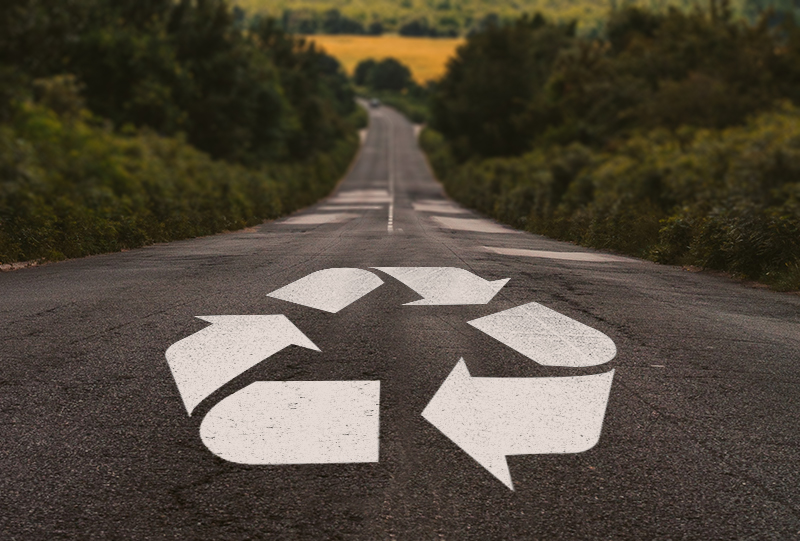With recycled plastic material you can make many products, as we wrote about in this article and on our Facebook page. But did you know that there are types of recycled plastic that are used to build important infrastructures such as roads, cycle lanes, and entire buildings?
Here are some of the most interesting projects!
Roads
The Provincial Ardeatina road is the first one made of graphene and recycled plastic. Ecopave, this is the name of the futuristic road surface, is more resistant to the passage of vehicles, anti-pollution, anti-ice, and long-lasting. The all-Italian project is the result of a patent from Iterchimica, a company that deals with technologies that improve asphalt performance.
In Zermatt, Switzerland, they are testing a special resistant and environmentally friendly road surface made by a Scottish company, consisting of recycled plastic waste mixed with bitumen. The creators of the project stated that in this way, about 16 thousand tons of plastic waste can be recycled in Switzerland alone!
Making railway sleepers in recycled rubber is a reality thanks to the start-up Greenrail™, the result of a technology that combines a mixture of rubber from end-of-life tires and plastic from urban waste. The first section for the Reggio Emilia – Sassuolo line has already been successfully inaugurated.
The company G.Eco, which has been operating in the environmental hygiene sector for many years, produces resistant asphalt by recycling 5 thousand tons of plastic every year. The project, now in the experimental phase, aims to produce asphalts with better resistance to climatic, thermal, and traffic stress, in addition to being a valid example of circular economy.
Buildings
There are houses made entirely of recycled plastic, using modular panels obtained thanks to the recycling of PET from hundreds of thousands of bottles. The most interesting aspect, in addition to sustainability, is given by the resistance of these prefabricated buildings, which can in fact withstand winds over 500km/h, have significant thermal insulation properties, protection from humidity and mould, and durability. The construction can also be completed in few weeks or even days!
Plastic waste recovered from the Po river transforms into shelter homes thanks to the ‘Il Po d’AMare’ project, which aims to put into practice innovative techniques to intercept the waste present in river waters. Using some of the plastic waste collected through the experimental polyethylene barriers installed in the Po river, innovative panels have been created that can be used to build low-cost shelter homes for communities that lost their houses due to natural disasters.
Building components
It is called ‘Granchio’ (crab): stay-in-place recycled polypropylene formwork that is used to make the foundations of buildings. The crab allows excellent ventilation of the structure and the reduction of humidity. The interlocking connection system makes it easy to lay, while the particular hollow shape allows pipes, cables, and ducts to be positioned in every direction.
The American start-up Byfusion has created a new way to recycle any type of plastic collected in the oceans and transform it into building bricks. It is a new technology which, without the use of glues or binders, compresses all types of plastic into a new building material, RePlast. RePlast blocks are robust and durable, with high thermal and acoustic insulation properties. They also guarantee 95% less greenhouse gas emissions than traditional bricks.
Cycle lanes and routes
There are virtuous Italian municipalities that have decided to invest in the recycling of plastic to redevelop the green areas intended for citizens, in particular for children and the elderly. With recycled plastic materials they made furniture, toys, benches, picnic tables, litter bins, fences, shelters for public transport, signage, and even equipment for people with disabilities.
The first cycle lane in recycled plastic was made in the Netherlands. It is the Plastic Road project, created by the KWS civil engineering company. The route is a prototype that lends itself to future creations such as sidewalks and parking lots, in addition to high-traffic roads. In Italy, a similar project is underway in Follonica, where they built the first cycle-pedestrian route in recycled plastic with thousands of bottles. After the test period, the administration plans to build a 250-meter-long path!
This is the plastic recycling we like – useful to the community and to the citizens. With everyone’s contribution, we can achieve great things, as these important recycling projects demonstrate.
Thanks to plastic waste we can really create something extraordinary!

